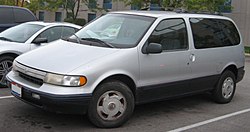Mercury Villager
| Mercury | |
|---|---|
|
Mercury Villager, 1992-1996
|
|
| Villager | |
| Production period: | 1992-2002 |
| Class : | Van |
| Body versions : | Station wagon |
| Engines: |
Petrol engines : 3.0–3.3 liters (110–126 kW) |
| Length: | 4823-4950 mm |
| Width: | 1872-1902 mm |
| Height: | 1666-1781 mm |
| Wheelbase : | 2450 mm |
| Empty weight : | 1730-1789 kg |
The Mercury Villager was a van built in two generations by the US car manufacturer Mercury from 1992 to 2002 .
Mercury had already used the name Villager in the 1960s and 1970s as a model name for station wagon models .
The Villager was the sister model of the Nissan Quest .
Model history
Mercury Villager and Nissan Quest were the result of a joint venture between Ford and Nissan . The purpose of the alliance was to build a smaller and more stylish minivan. Both models made their debut at the Detroit Motor Show in early 1992 and only differed from one another in their visual details; The Villager had the light strip between the headlights typical of the Mercury models of that time. Both had a Nissan engine and were produced at the Ford plant in Avon Lake, Ohio .
The first-generation Villager was available in three equipment levels: as a GS, as an LS and as a luxury version, the Nautica Special Edition. The Nautica had a two-tone paint (blue / white or red / white) and a yellow decorative stripe, leather upholstery in blue / gray or gray. A special feature of its time was the cornering light with which all Villagers were equipped as standard and the keyless entry, which is popular with Lincoln models in the USA, via a numerical code on the driver's door, which was only reserved for the very few and rare Lincoln Mercury Villager models.
The Villager / Quest joint venture suited both manufacturers; the Ford Aerostar was getting on in years and had fallen sharply in sales, while its successor Ford Windstar was still a long way off. Ford had the financial means to build an additional plant, but too little spare engineering capacity to develop the vehicle. Nissan, on the other hand, lacked the money, but was able to provide design services and contribute the engine built in the Nissan plant in Smyrna / Tennessee .
The Villager was initially very successful, but fell increasingly behind towards the end of the 1990s due to increased competition. In 1996 there was a small facelift in which the front section, headlights and rear lights were changed (the light strip between the headlights was omitted); A major facelift followed in 1999, but this did not stimulate sales, which is why Ford stopped Villager production and the joint venture shortly after the start of the 2002 vintage. The second generation Villager was available in the equipment levels Basic, Sport and Estate.
As a result, Nissan launched a new generation of Quest, while Mercury sold a variant of the Ford Freestar , the Mercury Monterey .

